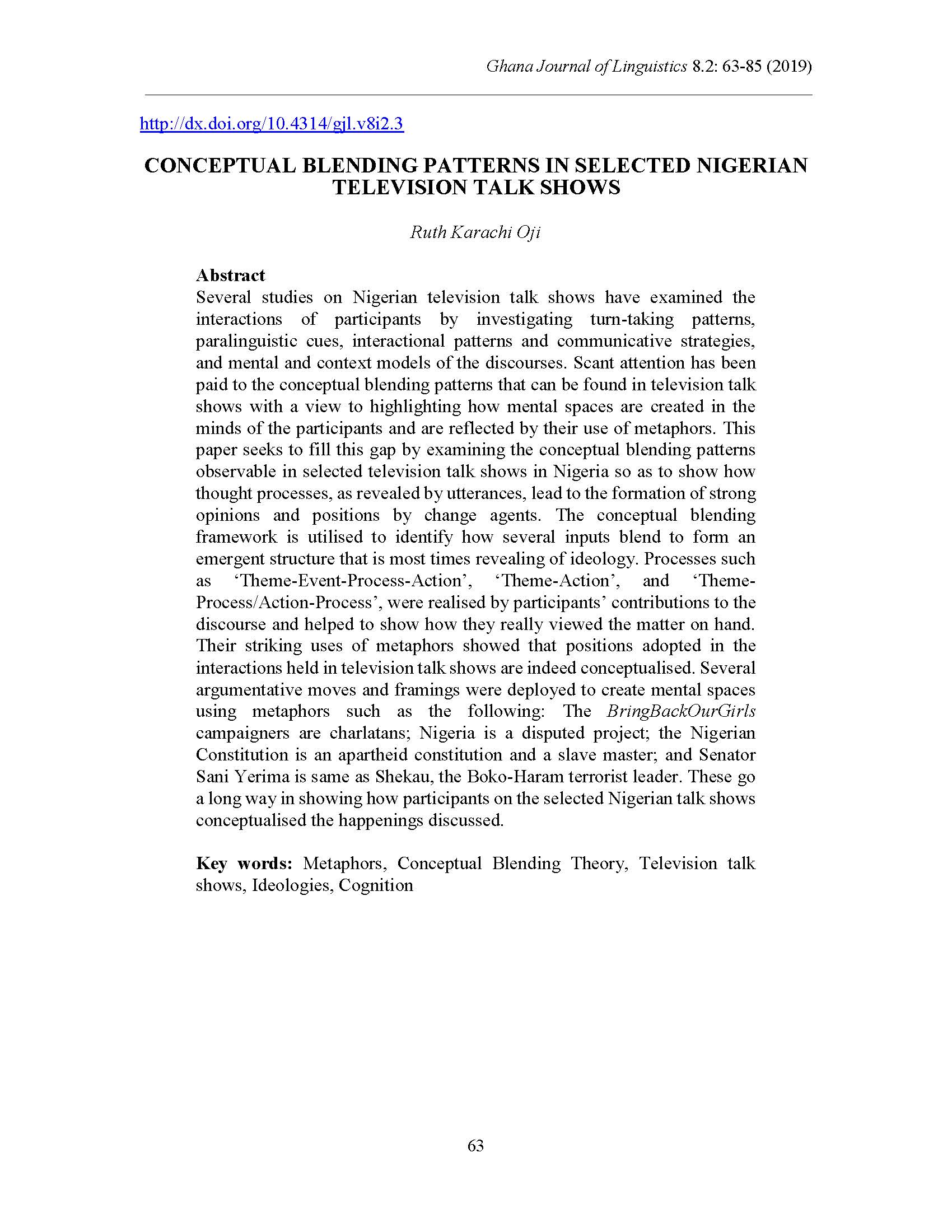Conceptual Blending Patterns in Selected Nigerian Television Talk Shows
DOI:
https://doi.org/10.4314/gjl.v8i2.199Keywords:
Conceptual blending patterns, Nigerian television talk shows, DiscourseAbstract
This paper seeks to examine the conceptual blending patterns observable in selected television talk shows in Nigeria so as to show how thought processes, as revealed by utterances, lead to the formation of strong opinions and positions by change agents. The conceptual blending framework is utilised to identify how several inputs blend to form an emergent structure that is most times revealing of ideology. Processes such as ‘Theme-Event-Process-Action’, ‘Theme-Action’, and ‘Theme-Process/Action-Process’, were realised by participants’ contributions to the discourse and helped to show how they really viewed the matter on hand. Their striking use of metaphors showed that their positions were indeed conceptualised.
References
Chilton, P. (2005) “Missing links in mainstream CDA: Modules, blends and the critical instinct”.
In A New Agenda in Critical Discourse Analysis: Theory, Methodology and Interdisciplinarity. Ed. Wodak, R. and Chilton, P. Amsterdam: John Benjamins, pp. 19-53.
Coulson, S. (2000) Semantic Leaps: Frame-shifting and Conceptual Blending in Meaning
Construction. Cambridge: Cambridge University Press.
Evans, V. (2006) The Structure of Time: Language, Meaning and Temporal Cognition.
Amsterdam: John Benjamin.
Fairclough, N. (1995) Critical Discourse Analysis: The critical study of language. London:
Longman.
Fauconnier, G. (1994) Mental Spaces: Aspects of Meaning Construction in Natural Language.
Cambridge: Cambridge University Press.
Fauconnier, G. and Turner, M. (1996) “Blending as a Central Process of Grammar”. In
Conceptual Structure, Discourse and Language. Ed. Goldberg, E. Stanford, California:
CSLI Publications, pp. 113-130.
Fauconnier, G. and Turner, M. (2002) The Way We Think: Conceptual Blending and the Mind’s
Hidden Complexities. New York: Basic Books.
Hart, C. (2007) “Critical Discourse Analysis and Conceptualisation: Mental Spaces, Blended
Spaces and Discourse Spaces in the British National Party”. In Cognitive Linguistics in
Critical Discourse Analysis Application and Theory. Ed. Hart, C. and Lukeš, D. UK: Cambridge Scholars Publishing.
van Dijk, T. (1995) “Discourse Analysis as Ideology Analysis”. In Language and Peace. Ed.
Schäffner, C. and Wenden, A. Amsterdam: Harwood Academic Publishers, pp. 17-36.
van Dijk, T. (2002) “Political Discourse and Political Cognition”. In Politics as Text and Talk:
Analytic Approaches to Political Discourse. Ed. Chilton, P. and Schäffner, C.
Amsterdam: John Benjamins, pp. 203-238.
Weiss, G. and Wodak, R. (2003) Critical Discourse Analysis: Theory and Interdisciplinarity.
Basingstoke: Palgrave Macmillan.

Downloads
Published
How to Cite
Issue
Section
License
The Ghana Journal of Linguistics is published by the Linguistics Association of Ghana, P. O. Box LG 61, Legon, Accra, Ghana.
LAG Email: linguisticsgh@gmail.com. Website: http://www.laghana.org
GJL Email: gjl@laghana.org Website: http://www.laghana.org/gjl
© Linguistics Association of Ghana and individual authors, 2023.
